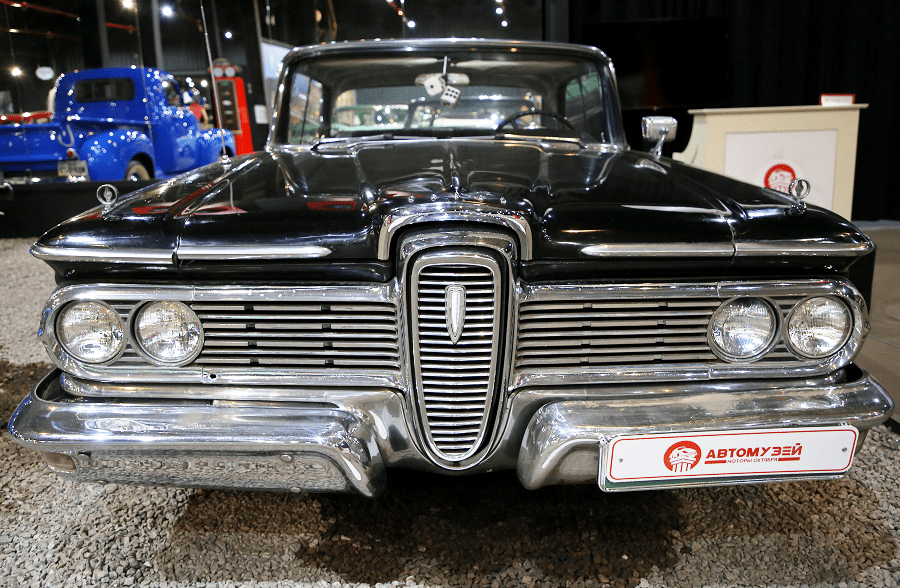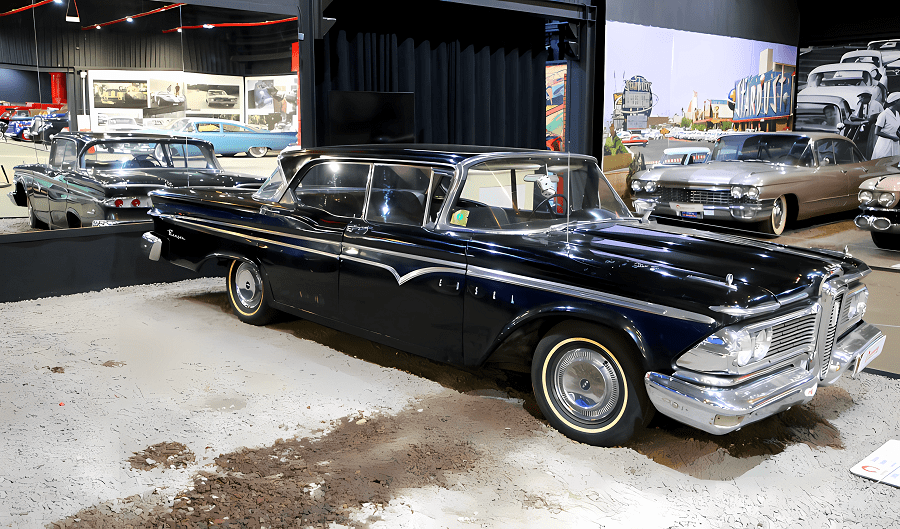Edsel Ranger (1st generation)
The Edsel Ranger is an automobile that was produced and sold by the newly formed Edsel Division of Ford for the 1958–1960 model years. It was built on the shorter, narrower Edsel platform, shared with Ford and Edsel Pacer models.
The Ranger was the base trim model for Edsel in its first and second years as an automotive marque. It was available in two-door coupes, four-door sedans, and two- and four-door hardtops with a convertible also offered in 1960.
Ranger is one of three of Edsel’s model nameplates reused by Ford Motor Company products, Villager and Corsair being the others.
I Generation (1958–1959)
The Ranger’s base trim appointments included arm rests, a cigarette lighter, rear-view mirror, two coat hangers, and black rubber floor mats. On the exterior, Rangers received chrome around the rear quarter-panel cove molding. Two-tone paint was also optional. The main visual cue that makes differentiating most Rangers and the upmarket Pacer possible was the lack of stainless trim on the front doors and fenders. A very rare, optional, Ranger-only door trim was available from dealers early in the model year to be used together with the Pacer fender trim. A basic heater (as a $92 option) and radio (at $95) were available, and air conditioning was optional, as well (at $417), along with seat belts, warning lights, automatic trunk opener, and rear-door child-safety lock covers.
The Ranger rode on Ford’s 118-inch (2997-mm) wheelbase (except the wagons, which used a 116-inch (2946-mm) wheelbase) and a 303 HP (226 kW) 361 cu in (5.9 L) FE V8 with a four-barrel carburetor was standard, as was a three-speed manual transmission. Buyers could upgrade to a three-speed automatic transmission with a standard column-mounted gear selector, or could choose Edsel’s highly promoted, but trouble-prone Teletouch automatic, which placed its drive-selection buttons in the steering wheel hub, as a $231 option. The 345 HP (257 kW) 410 cu in (6.7 L) MEL V8, standard in the Corsair and Citation, was not available.
While their roll-out was highly publicized in the fall of 1957, Edsels were a marketing disaster for Ford and for Ford’s corporate strategy for meeting General Motors’ product line for product line. Total U.S. and Canada Ranger output for the model stood at an estimated 21,301 units. Of those units, 4,615 were U.S.-built two-door sedans, 7,414 were four-door sedans (6,576 U.S./838 Canada), 6,005 were two-door hardtops (5,546 U.S./459 Canada), and 3,667 were four-door hardtops (3,077 U.S./190 Canada). Prices ranged from $2,529 to $2,990.
In regrouping for the coming model year, the best-selling Pacer and the premium Citation models were dropped for 1959, as was the trouble prone Teletouch transmission feature, which was replaced with the column-selector Mile-O-Matic (the Edsel division’s branding for the two-speed Fordomatic).
For 1959, the Ranger and the new top-line Corsair both shared the same 120-in wheelbase.[9] The frame was ladder-type. Styling for the cars became more conservative, with the horsecollar grille being replaced by a shield shape filled with rows of bars. Body styles for the Ranger remained at two-door sedans and four-door sedans, and two and four-door hardtop bodies; 7,778 two-door sedans (all U.S.-built), 14,063 four-door sedans (12,814 U.S./1,249 Canada), 5,966 hardtops (5,474 U.S./492 Canada), and 2,451 four-door hardtops (2,352 U.S./99 Canada) were produced for 1959 in the U.S. and Canada. Prices ranged from $2,629 to $2,756.
Assembly: Louisville (Kentucky, USA)
Years of production: 1958—1959
Production: 51,959 units
Length: 5415 mm
Width: 2002 mm
Height: 1443 mm
Engine: 8 cylinders; 5436 cc
Power: 232 HP
Max speed: 176 km/h
Fuel consumption: 20 l/100 km
Weight: 1790 kg
World cars museum (Moscow, Russia) and Encamp 2018 rally (Encamp, Andorra)
See also Transport blog
See also Cars blog
See also Motorcycles blog
See also Buses blog
See also Shipbuilding blog
See also Motors and Engines blog
See also Trains and railways blog
See also Trucks and Cargo Vehicles blog
See also Tractors and Special Equipment blog
See also Tanks and Armored Vehicles
See also Airplanes blog
See also Helicopters blog
See also Artillery, Missiles and Rockets blog
See also Bicycles blog














